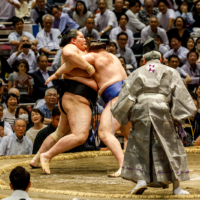The experience of 能楽 (nōgaku, noh theater) is difficult to describe. When you see this ancient Japanese performance art — masked deities and demons, slow and arrhythmic chanting, fiercely clattering dances that suddenly come to a halt — the first word that might come to mind is 不思議 (fushigi). This common word refers to things that are mysterious and unknowable, strange and incomprehensible, illogical or even a little upsetting.
In noh, this 不思議な感じ (fushigina kanji, mysterious feeling) may arise from the genre’s deep sense of 幽玄 (yūgen): a mysterious profundity and subtle elegance that defines much of noh’s aesthetic.
Once you move past the confusion and mystery, other feelings may surface. As strange beings dance and romp across the stage to the hum of the chorus and the piercing flute, you may feel 圧倒 (attō), a sense of being overwhelmed by the performance’s intensity. At other times, you may feel 共感 (kyōkan), an empathy for the characters on stage as they struggle and suffer.

















With your current subscription plan you can comment on stories. However, before writing your first comment, please create a display name in the Profile section of your subscriber account page.